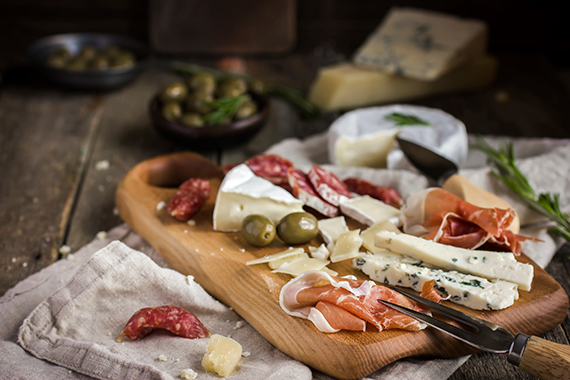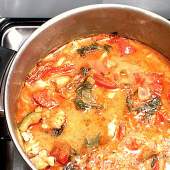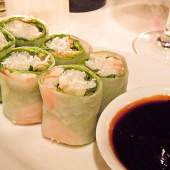Charcuterie

“Good meat can change the world” – The Butchers Guild
Charcuterie. This French term (pronounced shar-KOO-tuh-ree), despite its distinctly unappetizing English translation of “cooked flesh,” conjures up the pleasures of an upscale picnic spread, perhaps to be enjoyed with good friends at an outdoor symphony concert under the stars. A bottle or two of good wine; sliced French bread, small toasts, or thin crackers; sweet and savory spreads; some grapes or other bite-sized fruits, pickled vegetables, and olives (for more of an Italian flair); and the main event: a sumptuous array of cheeses and cured meats in a wide variety of textures, attractively arranged on a rustic wooden board.
This is not quite the same thing as the Oscar Mayer Lunchables® in a child's lunchbox, is it? Although perhaps to that generally uncritical constituency, it’s the thought that counts.
A charcuterie board at Bar Pastoral
A colorful charcuterie board has long been popular as a staple on a buffet table or as a group appetizer, but now, increasingly, restaurants are offering them as a main course with wine (and sometimes beer) pairings. There are even vegan and gluten-free options.
Although charcuterie is very much on trend right now, it might surprise you to learn that the practice is a very old one, taking many forms across many cultures over a span of more than 6,000 years, evolving out of a vital need to preserve surplus raw food before the advent of modern refrigeration. It was the ancient Romans who began experimenting with rudimentary methods of salting and smoking meats, but it was the French in the Middle Ages who truly elevated charcuterie to an art born out of necessity.
According to Charcuterie: The Craft of Salting, Smoking, and Curing by Michael Ruhlman and Brian Polcyn, early “charcutiers were not allowed to sell uncooked pork…so they created all manner of cooked (or salted or dried) dishes to be sold later – pâté, rillettes, sausage, bacon, and head cheese.” By the way, you should know that the oddly named “head cheese” is neither “head” nor “cheese,” but a “slow-cooked pork that is packed into a terrine or mold,” which, Ruhlman and Polcyn say, is not to be “confused with canned spam.”
Because the skill and ingenuity of the charcutier were vital to keeping his or her community fed during times when food might be scarce, these “meat artisans” enjoyed an elevated status among their fellow tradesmen. By the time of the French Revolution, there were master charcutiers plying their wares on seemingly every block in Paris. Their Old World curing traditions were carried over to the new one as settlers immigrated to America, and came to be valued as much for their practical uses as for the unusual flavors brought out in the meats by these preparations, which are designed to utilize all parts of an animal to eliminate waste and maximize taste.
So, what are the essential components of a really good charcuterie board? Not surprisingly, opinions vary greatly, and are often influenced by what is fresh, seasonal, and can be locally sourced. Online foodie destinations running the gamut from Epicurious and Bon Appétit to The Roasted Root to the National Hot Dog and Sausage Council and Cooking with Cocktail Rings offer a wealth of do-it-yourself advice. Their main point of consensus appears to be variety – combining hard, smoked, and spreadable meats (salami, sausage, prosciutto, pâté) and cheeses (aged, crumbly, creamy, sharp, mild) that complement each other; accompanied by sliced breads and crackers and an imaginative selection of condiments such as Dijon mustard, pesto, chutney, or preserves. Vegetables, fruits, and nuts are also popular additions.
Whether you find your ingredients at the local grocery store, at an artisan shop, try your hand at curing your own meats, or enjoy the work of a skilled charcutier at a restaurant, a well-curated charcuterie board, paired with wine, has the power to transport you to a simpler, more relaxed time and place, as you socialize and unwind with friends over a delicious meal. And isn’t that what dining out is all about?
Stay tuned to The World of Food each week to learn more about…the world of food!





